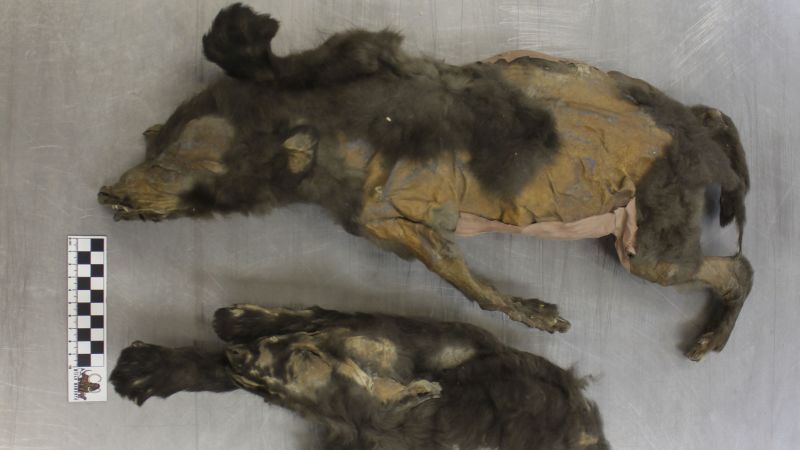In a fascinating exploration into ice age history, researchers have recently made a remarkable discovery in Northern Siberia. Two exquisitely preserved ice age “puppies,” known as the Tumat Puppies, have drawn scientific attention, challenging prior assumptions about their species. Instead of being classified as early domesticated dogs or tamed wolves, they are now believed to be 14,000-year-old wolf pups. This significant revelation stems from detailed genetic analysis and examination of their stomach contents, which included remnants of a woolly rhinoceros and bird feathers.
The remains of the Tumat Puppies were uncovered at the Syalakh site, situated about 25 miles from the village of Tumat. The preservation of these specimens is extraordinary, allowing scientists to uncover insights into their lives, habits, and diet. Initial perceptions had tied these animals closely to human lodging and behavior, especially given their proximity to human-altered remains, specifically woolly mammoth bones that were cut and burned. However, in-depth genetic data analysis revealed that these pups were two-month-old siblings, free from signs of human interaction.
Lead researcher Anne Kathrine Wiborg Runge expressed her astonishment at the level of preservation and the intricate details about the puppies’ life that researchers could decipher from their remains, which extended even to the last meal they consumed. Runge noted that many might be disappointed to learn that these pups are wolves, rather than our modern domesticated friends, yet their findings provide significant insight into their environment and lifestyle. The study also touched upon the ongoing struggle of researchers to pinpoint when dogs became an integral part of human society.
The fate of the Tumat Puppies signals a sudden demise—dying in a collapsed underground den over 14,000 years ago. According to the findings published in the journal “Quaternary Research,” the collapse may have been triggered by a landslide, an event that underscores the unpredictability of life during an ice age. Alongside physical examinations, the examination of the pups’ last meals has allowed researchers to garner information about their eating habits. Like today’s wolves, they consumed a shared diet of meat and plants. The study’s results attest to the complexity of their feeding behavior and provide a base for better understanding these ancient relatives to modern canids.
Throughout this research, scientists faced the overarching challenge of establishing a time frame and context for the domestication of dogs. The Tumat Puppies offer an interesting perspective, suggesting that domestication is a far more nuanced phenomenon than previously thought. Through genetic analysis, previous studies hinted at a lineage of extinct wolves that did not contribute genetically to modern dog breeds, aligning with the theory that domestication was a gradual evolution over generations.
Dr. Nathan Wales, a co-author of the study and a senior lecturer in archaeology at the University of York, emphasized the limitations inherent in tracing domestication. The absence of evidence tying the Tumat Puppies to the butchering site of mammoths suggested that these animals were not being actively cared for or fed by early humans, which indicates that they were likely raised in a natural pack environment. The findings of protein remnants, particularly from woolly rhino skins in their stomachs, further suggest that these pups were part of a functioning pack dynamic.
As researchers embark on decrypting more of the mysteries surrounding the domestication of dogs, they are required to look at varied lines of evidence—archaeological, morphological, genetic, and ecological—that can inform about their ancient interactions. The Tumat Puppies are a striking example of the nuances involved in studying the relationship between wolves and humans, forcing scientists to reconsider existing narratives and biases. Although the origins of domesticated dogs remain elusive, the age of the Tumat Puppies amplifies the rich tapestry of connections between humanity and their oldest companions; shedding light on this profound historical journey continues to be as alluring as it is complex.



